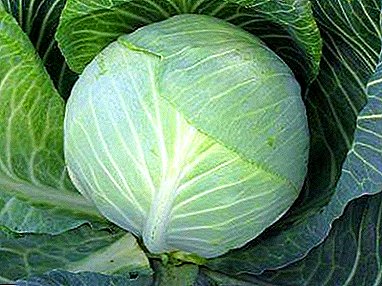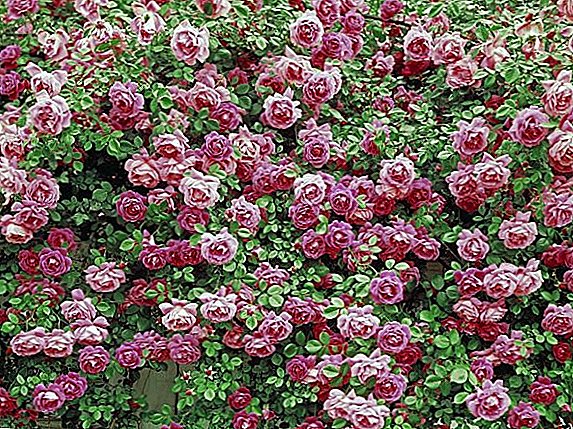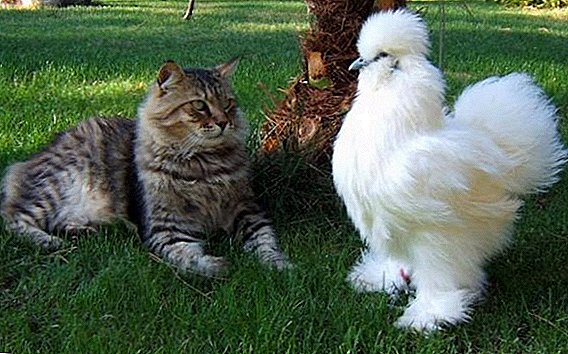 Chicken is the most common poultry that can be found anywhere in the world. When purchasing chicken meat or eggs, few of us thought that there were also exotic breeds of hens, and also these birds were bred for beauty and pleasure. In this article we will not talk about the usual laying hen, but about her sister beauty - Chinese silk chicken.
Chicken is the most common poultry that can be found anywhere in the world. When purchasing chicken meat or eggs, few of us thought that there were also exotic breeds of hens, and also these birds were bred for beauty and pleasure. In this article we will not talk about the usual laying hen, but about her sister beauty - Chinese silk chicken.
History of origin
Mention of this decorative breed can be found in the eastern literature of the XVI century, although it is known that its first representatives appeared about a thousand years ago in China. Later, Chinese silk hens began to spread in most countries of Asia, in the XVIII century, their appearance was recorded in Russia. On these chickens there are notes of the world famous traveler Marco Polo, compiled by him during a trip to China and Mongolia.  Scientists have not yet established the fact where such a strange bird came from, questioning the hypothesis of crossing chicken and rabbit, but also the theory of the domestication of Himalayan wild birds has not been proven.
Scientists have not yet established the fact where such a strange bird came from, questioning the hypothesis of crossing chicken and rabbit, but also the theory of the domestication of Himalayan wild birds has not been proven.
Pavlovskaya chicken (golden and silver) also has a decorative appearance.
Description and Features
Chinese silk chicken has a very bright and extremely attractive appearance, thanks to which it got its name and popularity. Its appearance and character have much in common with the familiar home hen.
Appearance
Chicken feathers do not have hooks that are traditional for this species of birds, with which they are held together. Because of this, their plumage is more like soft and airy fur. Feathers have a very flexible and thin rod and feels silky. For this distinctive feature of the birds and nicknamed Chinese silk hens, or snares (from the English. Silkie or Silky).  Coloring thoroughbred birds should be monotonous. Spotted representatives are rejected. but color allowed varied: white, black, yellow, red, blue and wild.
Coloring thoroughbred birds should be monotonous. Spotted representatives are rejected. but color allowed varied: white, black, yellow, red, blue and wild.
The skin of chickens is very different from the traditional home. Their skin is brownish blue, the bones are black, and the muscle fibers are greyish black. All this thanks to the natural pigment eumelanin.
Did you know? Each silk chicken has 5 fingers on a blue-black paw, each of which is covered with feather gloves. While the usual homely fingers are only 4.
The body is round and small in size with a small head on a flexible and agile neck, the back is wide and the sternum is well developed. The beak of the birds is slightly curved and elongated in black.  Chickens have a mass of 800-1000 g, and the roosters are slightly larger - 1100-1500 g. They have luxurious head of hair, beard and sideburns.
Chickens have a mass of 800-1000 g, and the roosters are slightly larger - 1100-1500 g. They have luxurious head of hair, beard and sideburns.
Check out egg and meat breed ratings.
Character
The "silk" character of the snare is not fiction. These birds are extremely calm and friendly, they are good to contact people. In China, the tendency to start silk birds as petswhich you can stroke and caress on your lap, coming in the evening with hard work. Due to this nature of chickens, they do not rarely live in contact zoos around the world, delighting children with their interesting appearance and desire to be friends.
Chinese hens hatch eggs well and take care of their offspring due to a well-developed instinct. The female can be outwardly distinguished from the rest by an awkward gait and calm and measured behavior, while the roosters are very brisk, ready to defend their family zealously, and therefore, often engage in battles for primacy and attention.  They love freedom of movement and independence, they only lump together in case of danger, wanting to feel the protection and contact of their relatives, whereas in ordinary times they prefer to lead an independent lifestyle and like to “rest” from each other in the hidden corners of the house.
They love freedom of movement and independence, they only lump together in case of danger, wanting to feel the protection and contact of their relatives, whereas in ordinary times they prefer to lead an independent lifestyle and like to “rest” from each other in the hidden corners of the house.
Productivity
Chickens of this breed ripen by 6-7 months. The first laying eggs will not exceed 35 g each and will have a light creamy shell. Further, the eggs can become more massive, but will not exceed 40 g. Chinese snares are not very productive. The average number of eggs per year ranges from 80-100 pcs., Which is not a lot for domestic breed, and not a few for decorative. Throw klushi can 3-4 years.
Tips for poultry farmers: egg production period in pullet chickens and vitamins for laying hens; why chickens peck eggs, carry small eggs, do not carry well.
Conditions of detention
Chinese silk hens unpretentious, they do not require special conditions of housing and feeding, however, experts recommend providing high-quality food that will favorably affect the appearance and health of birds. 
The room
Concerning housekeeping - silk birds do not need special conditions of the situation of their home. They do not even need to roost, because they do not know how to fly. Also in the house should be observed hygiene standards, should be regularly cleaned.
Learn more about the arrangement of the chicken house: choice and purchase; independent production and arrangement of the hen house (perch, nest).
Silks do not tolerate high humidity, dampness in a chicken coop and begin to ache if kept in fresh air in a rainy climate. When breeding Chinese hens, it is necessary to control this aspect.
Courtyard for walking
Silky do not need a mandatory daily walk, but in the warm season they can organize a small pen in which they will be protected and will be able to move comfortably and independently. If you can move freely, the performance of the cliché may increase. 
How to endure cold
Considering the issue of temperature, experts say that chickens of this breed can tolerate frosts of up to -5 ° C, but for egg production it is necessary to provide warmer and more comfortable conditions in the house and, of course, to have good lighting.
What to feed
First of all, it is necessary to say that the diet of young chickens and chickens differs somewhat from adult individuals, so let's consider their menu separately.
Learn more about the features and rules of keeping and feeding laying hens.
Young offspring
When chickens are born, it is necessary to organize their diet every two hours, gradually increasing it by 5-10 minutes, and upon reaching one month of age the interval between feeding should be 3 hours. Next, as they get older, feed young chickens recommended three times a day.  The diet of silk chickens should consist of quality products. It should be vegetables, cereals, dairy products and special feed.
The diet of silk chickens should consist of quality products. It should be vegetables, cereals, dairy products and special feed.
So, for example, Experts in their breeding recommend to include:
- necessarily boiled yolk;
- cottage cheese, sour cream, kefir (giving preference to a less fatty product);
- grain: millet, semolina, corn grits;
- boiled carrots or other vegetables;
- crushed egg shells;
- meat broth;
- fish oil (a few drops).
Be sure to in the house should be fresh and clean water in the water bowl.
It should be remembered that, in order to ensure the nutritional status of the younger generation with everything necessary for good growth and excellent appearance, in the menu of Chinese hens, besides the listed products, it is necessary to introduce special vitamin complexes, the percentage of which in the diet should be about 40%. 
Adults
Chinese chickens do not require specific feeding conditions, and the diet of an ordinary domestic chicken is quite suitable for them, however there are several expert advice on breeding these birdsto which you can listen:
- To preserve the perfect silk coat of hens, their menus should be enriched with nettle seeds, sunflower seeds and oatmeal flakes. These products can be added to the feeder no more than 2-3 times a week, because an excess of fat in them can adversely affect the health of the bird and cause overweight and low productivity;
- more than half of the feed should consist of a variety of cereals. Wheat, barley and rye can be called an excellent combination;
- shell, egg and fish meal should be present in the diet of adult Chinese chicken;
- in winter, you should pay more attention to food and add dried grass to it, nettle and alfalfa, hay will work well, and do not forget about vitamin supplements. Boiled vegetables are best served in a small amount, they are pre-heated a little;
- in the summer period, it is recommended to provide the chickens with the opportunity to move independently and tweak fresh weed, looking for bugs and worms in the controlled area of the organized pen.

Hatching instinct
Chinese silk hens like no one else can boast of their maternal instinct, thanks to which they are good and caring wedges.
Did you know? Chinese snares are often acquired or attracted to incubate the foundlings. They put eggs of pheasants, partridges, other wild or selective breeds of birds for which she can become a caring mother.
It is due to this feature in the breeding of Chinese silk chickens rarely use an incubator. A hen can provide the optimum temperature for the normal development of chicks. The survival rate of newborn chicks is 90%, which is quite high.
Chickens are born miniature with a tiny fluff on the head, from which their traditional tuft will later grow. They immediately need warmth and care. Their little body is round. At birth, you can already consider the color of their future plumage, but for good growth of feathers requires compliance with the temperature regime.
Warm living conditions play a significant role in the development and development of the snare, affecting their viability and health. In the first week, the recommended temperature is not below +30 ° C, which can then be lowered by 3 ° C every 5-7 days. At the age of one month for Chinese chickens, the optimum temperature can be called +18 ° C.
Do not forget about the threat of infections for chickens, which will require certain preventive measures. 
Advantages and disadvantages
The appeal of Chinese silk chickens is very high. among their merits can be noted:
- friendly and relaxed nature;
- well-developed incubation instinct. Silky - excellent hens;
- the high value of chicken meat, which has excellent taste and dietary properties;
- benefit of chicken meat because it has a unique content of vitamins and elements. It contains calcium, phosphorus, amino acids and vitamins;
- bird fluff is actively used in the agricultural industry;
- snares are unpretentious and do not require special conditions of detention.
Important! Chinese medicine notes that Chinese silk chicken meat is not inferior in its beneficial properties to ginseng and is used to treat headaches, tuberculosis and other diseases. In ancient times, it was used for the healing of serious diseases, and the modern pharmaceutical industry uses snares to produce powerful dietary supplements and drugs that have been tested and certified for quality.
Disadvantages of Chinese silk chickens include:
- low productivity compared with other breeds of chickens;
- high price. Silk chickens eggs cost $ 5 apiece, a chicken costs $ 7-8, while an adult hen costs $ 50;
- low prevalence. In order to start breeding this breed of chickens, you will need to contact a specialized pet shop, a professional farm.
Video: features of the content of hens
Reviews of Chinese Silk Chicken


Chinese silk chicken is very attractive, affable and unpretentious, so it can become both a decoration of your chicken house and a favorite pet. Chickens of this breed are excellent chicks and are ready to take care of their and even alien offspring, the main thing is to create for them warm, dry and comfortable conditions for this.












